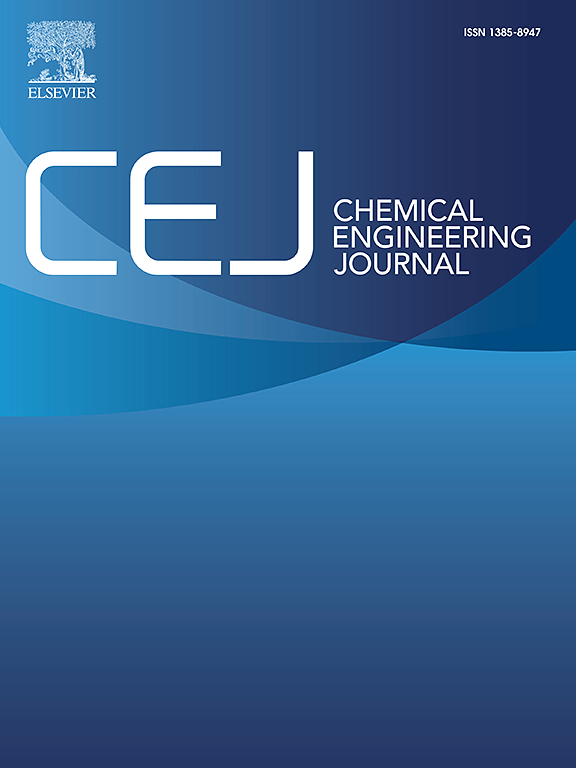Barium-induced compressive strain engineering in low-iridium Co3O4 spinel for high-efficiency acidic oxygen evolution
IF 13.2
1区 工程技术
Q1 ENGINEERING, CHEMICAL
引用次数: 0
Abstract
Iridium (Ir)-based materials are promising candidates for the acidic oxygen evolution reaction (OER) but face challenges such as high cost and aggregation. In this study, we synthesized a low-Ir-content Co3O4 spinel catalyst (IrBa-Co3O4 with 1.5 at. % Ir) via electrodeposition, where barium (Ba) doping introduces compressive strain to optimize Ir active sites while mitigating Ir aggregation into clusters or nanoparticles. Structural analyses, including X-ray diffraction (XRD), scanning transmission electron microscopy (STEM), and extended X-ray absorption fine structure (EXAFS), confirm atomic-level dispersion of Ir and Ba, lattice contraction, and shortened Co O bonds. X-ray photoelectron spectroscopy (XPS) and X-ray absorption near-edge structure (XANES) reveal electron transfer from Ir to Co/Ba, elevating Ir’s oxidation state and enhancing OER activity. In 0.5 M H2SO4, the IrBa-Co3O4 catalyst achieves 10 mA cm−2 at an overpotential of 249 mV and operates stable for 100 h, outperforming most reported spinel-type catalysts. In-situ electrochemical impedance spectroscopy (EIS), Raman spectroscopy, and XANES attribute the improved activity to compressive-strain-induced octahedral Co‑oxygen (Cooct-O) bond shortening and optimized Ir-O-Ba/Co coordination. This work demonstrates a strategy for designing cost-effective, durable acidic OER catalysts through synergistic doping and strain engineering.
O bonds. X-ray photoelectron spectroscopy (XPS) and X-ray absorption near-edge structure (XANES) reveal electron transfer from Ir to Co/Ba, elevating Ir’s oxidation state and enhancing OER activity. In 0.5 M H2SO4, the IrBa-Co3O4 catalyst achieves 10 mA cm−2 at an overpotential of 249 mV and operates stable for 100 h, outperforming most reported spinel-type catalysts. In-situ electrochemical impedance spectroscopy (EIS), Raman spectroscopy, and XANES attribute the improved activity to compressive-strain-induced octahedral Co‑oxygen (Cooct-O) bond shortening and optimized Ir-O-Ba/Co coordination. This work demonstrates a strategy for designing cost-effective, durable acidic OER catalysts through synergistic doping and strain engineering.

低铱Co3O4尖晶石钡致压应变工程高效酸性析氧
铱(Ir)基材料是酸性析氧反应(OER)的有前途的候选材料,但面临着高成本和聚集性等挑战。在这项研究中,我们合成了一种低ir含量的Co3O4尖晶石催化剂(IrBa-Co3O4, 1.5 at)。通过电沉积,其中钡(Ba)掺杂引入压缩应变来优化Ir活性位点,同时减轻Ir聚集成簇或纳米颗粒。结构分析,包括x射线衍射(XRD)、扫描透射电子显微镜(STEM)和扩展x射线吸收精细结构(EXAFS),证实了Ir和Ba的原子级色散、晶格收缩和缩短的CoO键。x射线光电子能谱(XPS)和x射线吸收近边结构(XANES)揭示了Ir向Co/Ba的电子转移,提高了Ir的氧化态,增强了OER活性。在0.5 M H2SO4中,IrBa-Co3O4催化剂在过电位249 mV下达到10 mA cm−2,稳定运行100 h,优于大多数报道的尖晶石型催化剂。原位电化学阻抗谱(EIS)、拉曼光谱和XANES将活性的提高归因于压缩应变诱导的八面体Co -氧(cocot - o)键缩短和优化的Ir-O-Ba/Co配位。这项工作证明了通过协同掺杂和应变工程设计具有成本效益,耐用的酸性OER催化剂的策略。
本文章由计算机程序翻译,如有差异,请以英文原文为准。
求助全文
约1分钟内获得全文
求助全文
来源期刊

Chemical Engineering Journal
工程技术-工程:化工
CiteScore
21.70
自引率
9.30%
发文量
6781
审稿时长
2.4 months
期刊介绍:
The Chemical Engineering Journal is an international research journal that invites contributions of original and novel fundamental research. It aims to provide an international platform for presenting original fundamental research, interpretative reviews, and discussions on new developments in chemical engineering. The journal welcomes papers that describe novel theory and its practical application, as well as those that demonstrate the transfer of techniques from other disciplines. It also welcomes reports on carefully conducted experimental work that is soundly interpreted. The main focus of the journal is on original and rigorous research results that have broad significance. The Catalysis section within the Chemical Engineering Journal focuses specifically on Experimental and Theoretical studies in the fields of heterogeneous catalysis, molecular catalysis, and biocatalysis. These studies have industrial impact on various sectors such as chemicals, energy, materials, foods, healthcare, and environmental protection.
 求助内容:
求助内容: 应助结果提醒方式:
应助结果提醒方式:


